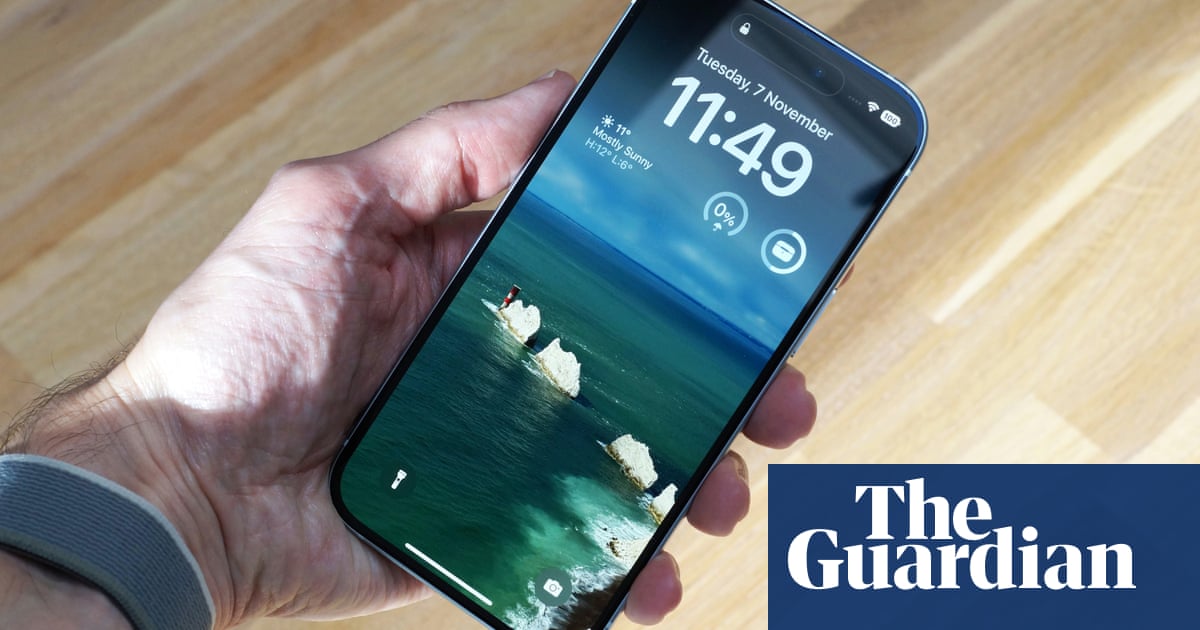The best iPhone may be the one you already own. There is generally no need to buy a fresh phone just because new models have been released, as hardware updates have broadly become iterative, adding small bits to an already accomplished package rather than reinventing the wheel.
But if you do want to replace it, either buying new or refurbished, here are the best of the current crop of Apple smartphones. Note: Apple is expected to release new models in September, which means it might be worth waiting to buy a new iPhone if you can.
Even if the new models are not on your radar, older models will be reduced in price, making them a better deal more or less overnight. This guide will be updated once the new models are tested, compared and ranked.
Best for most people: iPhone 15 Pro
The iPhone 15 Pro is the step-up option in Appleâs lineup and has all the latest features without being too big in your hand or pocket. The 6.1in OLED screen is bright and smooth with its 120Hz refresh rate â double that of cheaper iPhones â and is big enough for most things while keeping the handset relatively compact.
The 15 Pro also has a fancy new titanium body, which is stronger than the aluminium of other iPhones, and makes the phone significantly lighter than previous Pro models. The new âaction buttonâ replaces the mute switch, which you can set to open the camera or other useful features. The starting 128GB of storage will be fine if you store photos in the cloud, but those who need them stored locally should buy one of the more expensive versions with 256GB or 512GB storage.
The USB-C port handles charging and connecting a range of accessories, including practically any USB-C charger common to iPads, computers and Android phones, though it is not compatible with any older Lightning connector accessories. MagSafe in the back supports various accessories and Qi/Qi2 wireless charging at up to 15W.
It has a high (IP68) water-resistance rating â to depths of six metres for 30 minutes â and is more durable than previous generations. However, a good case is still needed to help it survive drops.
The 12MP selfie camera is the same as other recent iPhones for decent self-portraits. The triple camera on the back is excellent, featuring a 48MP main camera producing great-looking, detailed images across a range of lighting conditions, a solid 12MP ultra-wide camera for landscapes or big group shots, plus a good 12MP telephoto camera with a 3x optical zoom that cheaper iPhones donât have. The iPhone 15 Pro Max still has it beat on reach with its 5x optical zoom camera, however.
Another major advantage of the 15 Pro over the vanilla iPhone 15 is that it has the newer A17 Pro chip, which will be required to enable Appleâs new AI features for Siri, images, text and other generative bits that are due as part of the free iOS 18 in September. These âApple Intelligenceâ upgrades are likely to be key to many new core features for the iPhone going forward, so the 15 Pro is more futureproofed than cheaper models. It currently runs iOS 17 and will probably be supported by software updates for seven or more years, meaning you can keep it and use it for a long time.
The iPhone 15 Pro is now more than nine months old, so will be available refurbished if you want to make a more sustainable choice and save money.
Buy: from £999 at apple.com or £899 at johnlewis.com
Why should you buy it?
The iPhone 15 Pro is the sweet spot for performance, features, camera, price and futureproofing in Appleâs current lineup, with almost all the best bits without the massive screen and £200 extra cost of the iPhone 15 Pro Max.
Buy if: You want the Pro screen, titanium body, better camera and futureproofing without a massive display
Donât buy if: You want the best camera on an iPhone or a massive screen
Cheaper alternative: iPhone 15
The iPhone 15 is still good with more âProâ features than previous generations, including the modern âDynamic Islandâ notch design within its 6.1in OLED screen that was first introduced on the Pro line in 2022. It has a USB-C port and MagSafe for wireless charging, lasts a solid day on battery, feels snappy in use and starts with 128GB of storage just like the Pro models.
However, it has no optical zoom camera on the back, limited to just the good main and ultra-wide lenses, which means it lacks reach to distant subjects, making do with inferior digital zoom. It also lacks the new A17 Pro chip, which means despite the older A16 Bionic still being snappy, it wonât get the new Apple Intelligence features as part of iOS 18 in September. That makes it less futureproofed than the 15 Pro, despite likely being supported with software updates for a similar number of years.
Buy: from £799 at apple.com or £699 at johnlewis.com
Why should you buy it?
The cheaper iPhone 15 offers the standard iPhone experience at a relatively pocketable size for those who arenât interested in futureproofing.
Buy if: You want the default, good iPhone experience today
Donât buy if: You want optical zoom on your camera or upcoming AI features
Best for camera: iPhone 15 Pro Max
The iPhone 15 Pro Max is the Apple phone with everything maxed out. It has the biggest, brightest and fastest screen on an iPhone, measuring 6.7in, which is beautiful, but it makes the Pro Max a big phone in hands and pockets.
The phone also has all the trimmings of the regular 15 Pro, including the titanium sides and action button, but with a bigger battery for a longer running time and twice the starting storage at 256GB. The big upgrade for the iPhone 15 Pro Max, however, is a 5x optical zoom telephoto camera. It comes at about a £200 premium on its smaller âProâ sibling, placing it at the top end of the market.
Buy: £1,199 at apple.com or £1,099 at johnlewis.com
Why should you buy it?
The 15 Pro Max is the biggest and most advanced iPhone model, with upgrades across the board, the best of which is the 5x optical zoom on the camera.
Buy if: You want the best camera on an iPhone
Donât buy if: You donât want a massive screen
Best value new: iPhone SE (2022)
The iPhone SE is something of a throwback. It takes the old design of the iPhone â used until 2017 â complete with a Touch ID home button and chunky bezels around the screen, and puts a more modern chip at its heart.
The third-generation iPhone SE released in 2022 is still the best-value new iPhone, with an A15 Bionic chip from the 2021 iPhone 13 and 5G. The 4.7in screen is small and dim by modern standards, but the phone isnât that small due to the chunky design. It lacks Face ID and other modern iPhone bits, wonât get Apple Intelligence features and only has 64GB of storage at its base price. The single camera on the back is a bit weak.
Buy: £429 at apple.com or johnlewis.com
Why should you buy it?
The iPhone SE (2022) is the cheapest new iPhone.
Buy if: You want the best-value iPhone, but donât want to buy a refurbished model
Donât buy if: You want a modern iPhone experience or good camera
Others still on sale at Apple
The iPhone 14, released in 2022, has the older notch design but is still a good iPhone. Although not good value at its RRP of £699, this is one to look out for refurbished, with about five years of software support expected.
Buy: £699 at apple.com or £599 at johnlewis.com
The iPhone 13, released in 2021, is a model thatâs getting on a bit and is pricey at its RRP of £599. However, it could make for a solid refurbished buy with roughly four years of further software support expected.
Buy: £599 at apple.com or £499 at johnlewis.com; or £509 for a refurbished handset at apple.com
Replace or spruce up?
If your iPhone is running slow or the battery doesnât last as long as it used to, check its health in settings. If itâs past its best, a replacement battery costs £65 to £95 through Apple, or cheaper via third-parties, and will give your iPhone a new lease of life. Also, check you have enough free storage and clear out unused apps or content, offload photos and videos to the cloud or delete music. Aim for at least 2GB of free space.
If your phone is worn out, broken beyond repair or no longer receives crucial security updates, itâs time to upgrade. The latest software, version iOS 17, supports devices back to 2018âs iPhone XS/XR, so anything older should be replaced in the near future â though some older models may still receive occasional security updates from Apple.
What to look out for in a refurb?
Buying refurbished phones is better for the planet and your wallet. The iPhone makes for an excellent refurbished phone, typically staying responsive for years and being supported with software updates for about seven years from release, or longer in some circumstances. That means you can use an older model for several years before it will need replacing.
There are broadly two types of refurbished iPhone available: those refurbished and sold directly from Apple that come, essentially, as new, and those refurbished by third-parties that come in various grades or condition â but cost less.
The grades vary between retailers, but roughly you can expect:
-
Grade A: Virtually identical to a new phone on the outside, usually with the original box and accessories. These are often customer returns rather than trade-ins and are the most expensive.
-
Grade B: In full working order but typically with light scratches, dents or nicks, and may come with original accessories.
-
Grade C: In full working order but visibly worn and typically sold without their original accessories.
-
Grade D: Also known as âfor spares and repairsâ or similar. These are broken devices sold for people to fix or gut for parts.
There are many third-party retailers of refurbished phones. CeX and Game are popular UK high-street chains that deal in secondhand and refurbished phones. Established online retailers include MusicMagpie and Envirofone, while some phone operators also sell refurbished iPhones, including O2, GiffGaff, EE and Vodafone. Marketplaces such as Amazon, eBay and refurb-specialist BackMarket also have a wide range. Wherever you buy, there are certain things to look out for in any refurbished iPhone:
Battery health
Batteries wear out, typically only maintaining up to 80% of their original capacity after 500 full-charge cycles (about two to three years of nightly charging). Has it been replaced?
Charging port
Check for signs of damage, as the charging port could be one of the first parts to break.
Buttons
Check that all the buttons work without pressing too hard; a broken button could render the phone difficult to use and may be expensive to fix.
Touch ID/Face ID
Check the biometric features still work, as some repairs may cause them not to function.
Network locks
Check the iPhone works with your provider, as some are originally sold locked to networks and must be unlocked before being used on another.
Unauthorised parts
Not all repairs are done by the manufacturer or using certified parts, which can cause problems.
Check it isnât stolen
Check the iPhoneâs 15-digit IMEI (International Mobile Equipment Identity) number against a database of stolen phones through a service such as CheckMEND or similar.
Warranty
What kind of warranty does the retailer offer on its refurbished phones?
Do not buy
-
Any model older than an iPhone 12 because you wonât get many years of software support before youâll have to replace it.
-
Any iPhone 12 mini or iPhone 13 mini without a new battery. They both had relatively short battery life to start with, which meant more frequent charging than larger iPhones. Their batteries wear out faster, resulting in even shorter battery life.
How we test
We combine real-world testing alongside various tools, such as benchmarking systems that perform standardised tasks to measure performance, which help us to evaluate a phone, confirm that it performs as expected and to directly compare it with the competition and predecessors.
We use the phones out and about across a range of times and environments, from firing off emails on packed commuter trains to weekends spent shooting photos while walking in national parks, and everywhere in between. By doing all the things a typical smartphone user would, such as messaging, browsing, using myriad apps, listening to music, watching videos, playing games and navigating the real world, we get a good impression of how a smartphone handles the rigours of day-to-day life â including how long the battery lasts and how strong its wireless performance holds up. This is combined with results from specific tests, for things such as the camera zoom, video playback and charging, to inform the review and help rank phones.
Why should you trust me?
I have been reviewing consumer electronics for 16 years, with more than a decade spent as the Guardianâs gadget expert. In that time Iâve seen all manner of tech fads come and go, smartphone giants rise and fall, the cutting edge morph into the mainstream, and have poked, prodded and evaluated more than 1,000 devices â sometimes to destruction.



